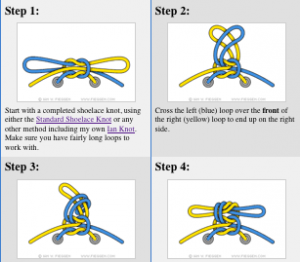Are You Tying Your Shoelaces Right?
Occasionally, I’ll look around the gym and see someone huffing and puffing on the treadmill—shoelaces flying through the air with each step. I can’t help but glance nervously at him every few minutes, waiting for him to trip and go shooting backwards off the machine. Running with loose shoelaces, whether on the pavement, trail or treadmill, is risky business. Tripping and falling can result in bruised knees and elbows (and egos), and stooping to fix them is just plain annoying, especially in the middle of a race.
Ian Fieggen has heard the sighs of frustration and answered their call. A Melbourne-based computer graphics guy who’s “passionate about efficiency,” Fieggen left his job four years ago to teach people full-time how to tie their laces in the fastest, most secure way possible. Turning the chore of tying your shoes into a science, Ian’s Shoelace Site features 18 different knots that vary in tying speed, security and balance. The site can be overwhelming with its detailed diagrams and technical overviews, but the “Shoelace Tips for Sports” section is worth taking a look at if you’re a regular runner.
That guy on the treadmill next to me should try Ian’s Secure Shoelace Knot. A slightly slower but more secure version of Fieggen’s self-created Ian Knot, the Secure Knot is a six-step procedure. As your foot presses against the knot through your shoe, the tension actually pulls it tighter instead of loosening it. Fieggen can also make your run more comfortable with his lacing tips. To reduce pressure on the upper ridge of the foot, runners should use the Criss-Cross, Straight, or Bow-Tie lacing methods, and only with flat laces. (Find instructions for all of these on his site). But is such a mountain of information necessary for something so trivial? Isn’t it a little much to be inundated with shoe-tying techniques like we’re back in kindergarten? Local running aficionados think so.
Gavin McKay, owner of Fusion Cross Training and co-organizer for Team Philly Race Training, says it’s all about finding the fit that works for you: “In some sports there is a reason to tie your shoes tight but not in running or fitness. Too tight will not allow room for your feet to expand as you heat up and run, making it uncomfortable and affecting your time and endurance. For them to be just right, you should be able to slip them on and off without untying them. I never untie my sneakers.”
Seth Weiss, a racer and run leader for Philly Runners, echoes this sentiment: “I’d be skeptical that the way the shoelace is tied could fix [a] problem. I probably wouldn’t put in the effort to learn how to tie a new knot.” – Kathryn Siegel



